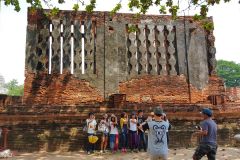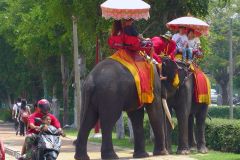After its foundation around 1350 the glorious city of Ayutthaya grew into becoming the second capital of Siam after Sukhothai.
The capital benefited from a strategic position and attracted traders from near and far. In fact the city become the world’s largest city around 1700 with 1 million inhabitants, and had permanent residents from a number of countries in Europe and Asia.
The prosperous palaces were beyond imagination, the temples were filled with gold and devout worshippers, and the large monasteries provided teachings for thousands. Its prominence ended suddenly in 1767 when it was invaded by Burmese forces and burnt to the ground.
Today it is a UNESCO World Heritage Site, there are lots of ruins to be seen, and some of the temples have become renewed. It is popular among day-trippers out of Bangkok as well as countless Thai people coming here to worship.
The map at the end of this article highlights the most important sights to be visited in glorious Ayutthaya. Most of them are situated on an island, sort of, with rivers on all sides. If you have the time and interest there are countless more to be seen. Like me you will probably be satisfied with a limited number of temples. I went to four.
Wat Yai Chai Mongkol

The reclining Buddha in Wat Yai Chai Mongkol
This temple is also written Wat Yai Chaimongkon. It is situated outside of the main “island” but remains a very popular and highly photogenic temple. You will be left at the large parking lot outside and by entering the gate you will be struck by the huge number of bricks making up most of the constructions inside the site.
In this former monastery there are at least three structures worth seeking out. To your left as you enter the gate you will find a large reclining Buddha in saffron robes, set inside the remains of a former viharn (assembly hall). To me, a non-believer, this seemed like a very popular place to circle.
Next, over on the right side of the complex is the huge chedi (stupa or pagoda) with a saffron robe around its upper levels. Third, the rows of Buddha images lining the chedi are quite amazing.
Apart from this it is always a pleasure to walk around at a leisurely pace and seek out the details, watch the worshippers performing their rituals, as well as the non-worshippers going about with their business.
The next three temples in the glorious city Ayutthaya are all located on the island.
Wat Mahathat

Having their photos taken, at Wat Mahathat
Surprisingly this royal temple actually housed Buddha’s relics. According to a sign at the entrance the construction of this temple was begun in 1374, it collapsed in 1633 and was set on fire in the Burmese attack. Since then very little has been done to restore it. That is why it is a lovely place to visit.
Even if you do not like ruins that much, Wat Mahathat will appeal to you. Have a look at it from the shade of the high trees near the entrance, walk right until you discover the Buddha tree.
It will undoubtedly remind you of Angkor, you know the Cambodian temple complex with all the tree roots growing in between rocks, bricks and statues. Continue your walk around the ruins and notice that some of them actually have the plaster on the bricks intact. Or have been re-plastered after the destruction for all I know. Why the Burmese seemingly decapitated so many Buddha images goes beyond my imagination.
Coming up next is a double complex.
Wihan Phra Mongkhon Bophit

This is what Wihan Phra Mongkhon Bophit looked like before its restoration (reconstruction)
This next temple does not look like it belongs to the ruins of Ayutthaya. It was rebuilt in 1956 and has the appearance of any other modern Buddhist temple in Thailand. In fact, the temple dates back to 1448 when its construction started.
It houses one of the largest bronze Buddha image in Thailand, more than 12 metres high on top of the base. It can get quite crowdy inside the temple, not with tourists but Thais.
Wat Phra Si Sanphet

Stupa and ruins inside the Wat Phra Si Sanphet
The last temple is situated next to the previous and was the largest in Ayutthaya. It was set inside the royal palace complex and was meticulously destroyed by the Burmese. A huge Buddha (16m tall and covered with 340 kg of gold, was destroyed and the gold melted.
There is very little left of the palace, but the temple grounds are worth visiting unless you by now have become tired of piles of bricks, Buddha statues and stupas more or less in the process of tipping over.
Conclusion
If I had spent more time here in glorious Ayutthaya I would have sought out the settlements outside the city centre belonging to foreign dignitaries and tradesmen. In particular the Dutch lodge, the Japanese (rebuilt) park, and the Portuguese ruins and church are recommended.
The four temples I visited gave me an idea of the splendour once enjoyed by the royals and other nobility in Siam, as well as offering a flashback to my visits to Angkor and Bagan. Unless you prefer shopping in Bangkok this is worth the effort of getting here.

Riding an elephant is also a means of transportation in Ayutthaya
Practical advice
Most temples in Ayutthaya are situated in a rather small area, but big enough to make you sweat if you want to walk. I would suppose most foreigners arrive on tours from Bangkok, but you can easily take a train from the present capital and hire a tuk-tuk driver for the day.
This article is part of series from a 24-hour visit to Bangkok. See the rest of the posts at the bottom.
Here is my map showing the most important sights of Bangkok. As always I made a rather good job at identifying and then selecting the places I wanted to go. I found time for only a few, and your priorities might differ. Zoom in on Ayutthaya and out as you wish, click the markers and expand the map into a separate window for more details.
All articles in this series:
(1) Summary of a 24 hour visit
(2) An excursion to the once glorious capital of Ayutthaya
(3) Harmonies in the Bang Pa-In Palace (NEXT)
(4) Glitter, gold and emerald in The Grand Palace
(5) The lovely sound of Wat Pho’s bronze bowls
More to read: You may also want to read my World Heritage Site article about Ayutthaya. Bangkok was a short stop on my way to the Himalayas.
Click on the images below to expand and browse.
















